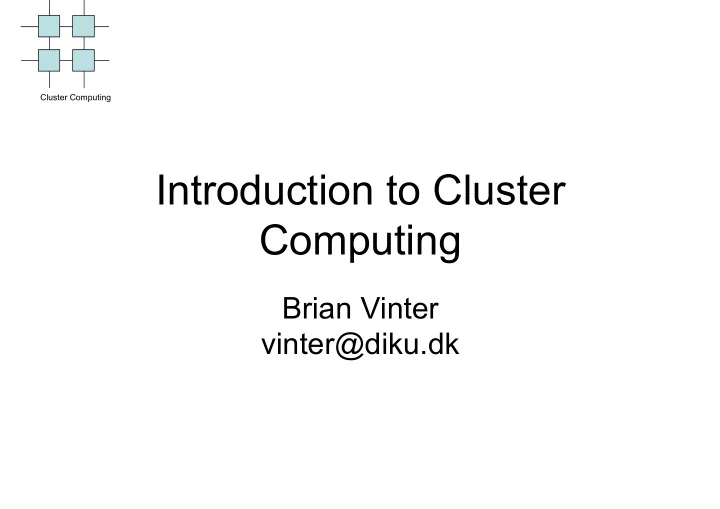

Cluster Computing Introduction to Cluster Computing Brian Vinter vinter@diku.dk
Overview Cluster Computing • Introduction • Goal/Idea • Phases • Assignments • Tools • Timeline/Exam • General info
Introduction Cluster Computing • Supercomputers are expensive • Workstations are cheap • Supercomputers from workstations are cheap (but they may be hard to program) • Several approaches to this problem exist
Goal/Idea Cluster Computing • The goal is that after this class you will be able to solve supercomputing class problems using a 'cheap' cluster solution • The idea is that the only real way to learn this is by solving a set of problems - using a cluster
Approach Cluster Computing • Model classic supercomputer architectures to clusters • Port the basic software from the SC architectures • Emulate the hardware that might be missing
Phases Cluster Computing • The class will cover five distinct approaches to cluster computing: • Physical Shared Memory (not a cluster actually) • Abstract Machines • Emulated Massively Parallel Processors • Emulating Remote Memory Machines • Distributed Shared Memory
Evolution Cluster Computing
Tools Cluster Computing • All the tools will be available in time (I hope) • We will (primarely) use Python for programming • In fact the choice of language is free but one language will be recommended for each step • Other tools that will be covered are: • Parallel Virtual Machines • Message Passing Interface • Remote Method Invocation • Tspaces, PastSet and TMem
Tools Cluster Computing • Most tools are available in identical or similar form for use with other languages • All the tools should be considered experimental and problems should be reported to me ASAP
Litterature Cluster Computing • Notes • Papers • I can suggest books as they are needed
Assignments Cluster Computing • There will be five (5) programming assignments, one for each phase we cover • All assignments will be fun!
Assignments Cluster Computing • This is a class on cluster computing, thus the assignments will be accompanied by a sequential version of the problem, that you can work from • Assignments must be documented and a report (there will be a page limit) submitted with the code • In the end you only need to hand in 3 assignments
Assignments Cluster Computing
General Idea Cluster Computing • We cannot hope to implement one SC application within one class – let alone five! • Most SC applications are based on a computational kernel which is fairly small and which takes up as much as 99.999...% of the total runtime • You will port sequential verisons of such kernels to run on clusters • To make it all fun we simulates cartoon traps
Road Map Cluster Computing • Fractals are examples of applications of the type we call embarrassingly parallel • A typical example of an compute intensive application with many independent sub- results • Very simple to write • Achieves very good speedup
Road Map Cluster Computing
Race Trap Cluster Computing • Traveling Salesman Problem is a classic supercomputing problem • The chosen algorithm is a typical Producer-Consumer approach • Is representative for global optimization problems • May achieve good speedup
Race Trap Cluster Computing
Wind Trap Cluster Computing • Virtual wind-tunnel • An actual scientific application • 2D – but a 3D model exists that use the same access pattern • Represents the pipelined application type • Can achieve really good speedup
Wind Trap Cluster Computing
Frosty Trap Cluster Computing • Successive Over Relaxation • A very common computational kernel in many scientific applications • A typical example of grid-communication applications • Can achieve very good speedup
Frosty Trap Cluster Computing
Clone Machine Cluster Computing • Ray tracing is a real computational problem • An example of an application that can achieve perfect speedup with small problems and good speedup on large (real) problems
Clone Machine Cluster Computing
eScience Track Cluster Computing • eScience is a new field at KU – Masters of eScience (cand scient escience) will start September 1st • Starting next year this class will be given in the eScience context – Thus there are new assignments on their way • You can choose to do these assignments instead of the original ones – The older ones are well tested the new ones are not!!!
Tumor treatment Cluster Computing • Monte Carlo simulations are examples of applications of the type we call embarrassingly parallel • A typical example of an compute intensive application with many independent sub- results • Very simple to write • Achieves very good speedup
Tumor treatment Cluster Computing
Tumor treatment Cluster Computing
Protein Folding Cluster Computing • Protein is an actual supercomputing problem • The chosen simplifications and algorithm is a typical Producer-Consumer approach • Is representative for global optimization problems • May achieve good speedup
Protein folding Cluster Computing
Wind Tunnel Cluster Computing • Virtual wind-tunnel • An actual scientific application • 2D – but a 3D model exists that use the same access pattern • Represents the pipelined application type • Can achieve really good speedup
Wind Tunnel Cluster Computing
Heat Equation Cluster Computing • Successive Over Relaxation • A very common computational kernel in many scientific applications • A typical example of grid-communication applications • Can achieve very good speedup
Heat Equation Cluster Computing
NBody Dynamics Cluster Computing • An actual application • Widespread use with different forces • Can be pipelinede • And achieve really good speedup
NBody Simulation Cluster Computing
Exam Cluster Computing • 3 of your assignments written into one delivery
Recommend
More recommend